-
EXECUTIVE SUMMARY
-
Market Overview
-
Key Findings
-
Market Segmentation
-
Competitive Landscape
-
Challenges and Opportunities
-
Future Outlook
-
MARKET INTRODUCTION
-
Definition
-
Scope of the study
- Research Objective
- Assumption
- Limitations
-
RESEARCH METHODOLOGY
-
Overview
-
Data Mining
-
Secondary Research
-
Primary Research
- Primary Interviews and Information Gathering Process
- Breakdown of Primary Respondents
-
Forecasting Model
-
Market Size Estimation
- Bottom-Up Approach
- Top-Down Approach
-
Data Triangulation
-
Validation
-
MARKET DYNAMICS
-
Overview
-
Drivers
-
Restraints
-
Opportunities
-
MARKET FACTOR ANALYSIS
-
Value chain Analysis
-
Porter''s Five Forces Analysis
- Bargaining Power of Suppliers
- Bargaining Power of Buyers
- Threat of New Entrants
- Threat of Substitutes
- Intensity of Rivalry
-
COVID-19 Impact Analysis
- Market Impact Analysis
- Regional Impact
- Opportunity and Threat Analysis
-
ELECTRIC FUSE MARKET, BY TYPE (USD BILLION)
-
Cartridge Fuses
-
Blade Fuses
-
Glass Fuses
-
Resettable Fuses
-
ELECTRIC FUSE MARKET, BY APPLICATION (USD BILLION)
-
Automotive
-
Industrial
-
Electronics
-
Renewable Energy
-
ELECTRIC FUSE MARKET, BY VOLTAGE RATING (USD BILLION)
-
Low Voltage
-
Medium Voltage
-
High Voltage
-
ELECTRIC FUSE MARKET, BY END USE INDUSTRY (USD BILLION)
-
Automotive Industry
-
Electrical Electronics Industry
-
Power Generation Industry
-
ELECTRIC FUSE MARKET, BY REGIONAL (USD BILLION)
-
North America
- US
- Canada
-
Europe
- Germany
- UK
- France
- Russia
- Italy
- Spain
- Rest of Europe
-
APAC
- China
- India
- Japan
- South Korea
- Malaysia
- Thailand
- Indonesia
- Rest of APAC
-
South America
- Brazil
- Mexico
- Argentina
- Rest of South America
-
MEA
- GCC Countries
- South Africa
- Rest of MEA
-
COMPETITIVE LANDSCAPE
-
Overview
-
Competitive Analysis
-
Market share Analysis
-
Major Growth Strategy in the Electric Fuse Market
-
Competitive Benchmarking
-
Leading Players in Terms of Number of Developments in the Electric Fuse Market
-
Key developments and growth strategies
- New Product Launch/Service Deployment
- Merger Acquisitions
- Joint Ventures
-
Major Players Financial Matrix
- Sales and Operating Income
- Major Players RD Expenditure. 2023
-
COMPANY PROFILES
-
General Electric
- Financial Overview
- Products Offered
- Key Developments
- SWOT Analysis
- Key Strategies
-
Littelfuse
- Financial Overview
- Products Offered
- Key Developments
- SWOT Analysis
- Key Strategies
-
Siemens
- Financial Overview
- Products Offered
- Key Developments
- SWOT Analysis
- Key Strategies
-
Cooper Industries
- Financial Overview
- Products Offered
- Key Developments
- SWOT Analysis
- Key Strategies
-
Mersen
- Financial Overview
- Products Offered
- Key Developments
- SWOT Analysis
- Key Strategies
-
Moonbell
- Financial Overview
- Products Offered
- Key Developments
- SWOT Analysis
- Key Strategies
-
ABB
- Financial Overview
- Products Offered
- Key Developments
- SWOT Analysis
- Key Strategies
-
Ferrocontrol
- Financial Overview
- Products Offered
- Key Developments
- SWOT Analysis
- Key Strategies
-
Bel Fuse
- Financial Overview
- Products Offered
- Key Developments
- SWOT Analysis
- Key Strategies
-
Roxtec
- Financial Overview
- Products Offered
- Key Developments
- SWOT Analysis
- Key Strategies
-
TE Connectivity
- Financial Overview
- Products Offered
- Key Developments
- SWOT Analysis
- Key Strategies
-
Eaton
- Financial Overview
- Products Offered
- Key Developments
- SWOT Analysis
- Key Strategies
-
Rockwell Automation
- Financial Overview
- Products Offered
- Key Developments
- SWOT Analysis
- Key Strategies
-
SIBA
- Financial Overview
- Products Offered
- Key Developments
- SWOT Analysis
- Key Strategies
-
Schneider Electric
- Financial Overview
- Products Offered
- Key Developments
- SWOT Analysis
- Key Strategies
-
APPENDIX
-
References
-
Related Reports
-
LIST OF TABLES
-
LIST OF ASSUMPTIONS
-
NORTH AMERICA ELECTRIC FUSE MARKET SIZE ESTIMATES & FORECAST, BY TYPE, 2019-2032 (USD BILLIONS)
-
NORTH AMERICA ELECTRIC FUSE MARKET SIZE ESTIMATES & FORECAST, BY APPLICATION, 2019-2032 (USD BILLIONS)
-
NORTH AMERICA ELECTRIC FUSE MARKET SIZE ESTIMATES & FORECAST, BY VOLTAGE RATING, 2019-2032 (USD BILLIONS)
-
NORTH AMERICA ELECTRIC FUSE MARKET SIZE ESTIMATES & FORECAST, BY END USE INDUSTRY, 2019-2032 (USD BILLIONS)
-
NORTH AMERICA ELECTRIC FUSE MARKET SIZE ESTIMATES & FORECAST, BY REGIONAL, 2019-2032 (USD BILLIONS)
-
US ELECTRIC FUSE MARKET SIZE ESTIMATES & FORECAST, BY TYPE, 2019-2032 (USD BILLIONS)
-
US ELECTRIC FUSE MARKET SIZE ESTIMATES & FORECAST, BY APPLICATION, 2019-2032 (USD BILLIONS)
-
US ELECTRIC FUSE MARKET SIZE ESTIMATES & FORECAST, BY VOLTAGE RATING, 2019-2032 (USD BILLIONS)
-
US ELECTRIC FUSE MARKET SIZE ESTIMATES & FORECAST, BY END USE INDUSTRY, 2019-2032 (USD BILLIONS)
-
US ELECTRIC FUSE MARKET SIZE ESTIMATES & FORECAST, BY REGIONAL, 2019-2032 (USD BILLIONS)
-
CANADA ELECTRIC FUSE MARKET SIZE ESTIMATES & FORECAST, BY TYPE, 2019-2032 (USD BILLIONS)
-
CANADA ELECTRIC FUSE MARKET SIZE ESTIMATES & FORECAST, BY APPLICATION, 2019-2032 (USD BILLIONS)
-
CANADA ELECTRIC FUSE MARKET SIZE ESTIMATES & FORECAST, BY VOLTAGE RATING, 2019-2032 (USD BILLIONS)
-
CANADA ELECTRIC FUSE MARKET SIZE ESTIMATES & FORECAST, BY END USE INDUSTRY, 2019-2032 (USD BILLIONS)
-
CANADA ELECTRIC FUSE MARKET SIZE ESTIMATES & FORECAST, BY REGIONAL, 2019-2032 (USD BILLIONS)
-
EUROPE ELECTRIC FUSE MARKET SIZE ESTIMATES & FORECAST, BY TYPE, 2019-2032 (USD BILLIONS)
-
EUROPE ELECTRIC FUSE MARKET SIZE ESTIMATES & FORECAST, BY APPLICATION, 2019-2032 (USD BILLIONS)
-
EUROPE ELECTRIC FUSE MARKET SIZE ESTIMATES & FORECAST, BY VOLTAGE RATING, 2019-2032 (USD BILLIONS)
-
EUROPE ELECTRIC FUSE MARKET SIZE ESTIMATES & FORECAST, BY END USE INDUSTRY, 2019-2032 (USD BILLIONS)
-
EUROPE ELECTRIC FUSE MARKET SIZE ESTIMATES & FORECAST, BY REGIONAL, 2019-2032 (USD BILLIONS)
-
GERMANY ELECTRIC FUSE MARKET SIZE ESTIMATES & FORECAST, BY TYPE, 2019-2032 (USD BILLIONS)
-
GERMANY ELECTRIC FUSE MARKET SIZE ESTIMATES & FORECAST, BY APPLICATION, 2019-2032 (USD BILLIONS)
-
GERMANY ELECTRIC FUSE MARKET SIZE ESTIMATES & FORECAST, BY VOLTAGE RATING, 2019-2032 (USD BILLIONS)
-
GERMANY ELECTRIC FUSE MARKET SIZE ESTIMATES & FORECAST, BY END USE INDUSTRY, 2019-2032 (USD BILLIONS)
-
GERMANY ELECTRIC FUSE MARKET SIZE ESTIMATES & FORECAST, BY REGIONAL, 2019-2032 (USD BILLIONS)
-
UK ELECTRIC FUSE MARKET SIZE ESTIMATES & FORECAST, BY TYPE, 2019-2032 (USD BILLIONS)
-
UK ELECTRIC FUSE MARKET SIZE ESTIMATES & FORECAST, BY APPLICATION, 2019-2032 (USD BILLIONS)
-
UK ELECTRIC FUSE MARKET SIZE ESTIMATES & FORECAST, BY VOLTAGE RATING, 2019-2032 (USD BILLIONS)
-
UK ELECTRIC FUSE MARKET SIZE ESTIMATES & FORECAST, BY END USE INDUSTRY, 2019-2032 (USD BILLIONS)
-
UK ELECTRIC FUSE MARKET SIZE ESTIMATES & FORECAST, BY REGIONAL, 2019-2032 (USD BILLIONS)
-
FRANCE ELECTRIC FUSE MARKET SIZE ESTIMATES & FORECAST, BY TYPE, 2019-2032 (USD BILLIONS)
-
FRANCE ELECTRIC FUSE MARKET SIZE ESTIMATES & FORECAST, BY APPLICATION, 2019-2032 (USD BILLIONS)
-
FRANCE ELECTRIC FUSE MARKET SIZE ESTIMATES & FORECAST, BY VOLTAGE RATING, 2019-2032 (USD BILLIONS)
-
FRANCE ELECTRIC FUSE MARKET SIZE ESTIMATES & FORECAST, BY END USE INDUSTRY, 2019-2032 (USD BILLIONS)
-
FRANCE ELECTRIC FUSE MARKET SIZE ESTIMATES & FORECAST, BY REGIONAL, 2019-2032 (USD BILLIONS)
-
RUSSIA ELECTRIC FUSE MARKET SIZE ESTIMATES & FORECAST, BY TYPE, 2019-2032 (USD BILLIONS)
-
RUSSIA ELECTRIC FUSE MARKET SIZE ESTIMATES & FORECAST, BY APPLICATION, 2019-2032 (USD BILLIONS)
-
RUSSIA ELECTRIC FUSE MARKET SIZE ESTIMATES & FORECAST, BY VOLTAGE RATING, 2019-2032 (USD BILLIONS)
-
RUSSIA ELECTRIC FUSE MARKET SIZE ESTIMATES & FORECAST, BY END USE INDUSTRY, 2019-2032 (USD BILLIONS)
-
RUSSIA ELECTRIC FUSE MARKET SIZE ESTIMATES & FORECAST, BY REGIONAL, 2019-2032 (USD BILLIONS)
-
ITALY ELECTRIC FUSE MARKET SIZE ESTIMATES & FORECAST, BY TYPE, 2019-2032 (USD BILLIONS)
-
ITALY ELECTRIC FUSE MARKET SIZE ESTIMATES & FORECAST, BY APPLICATION, 2019-2032 (USD BILLIONS)
-
ITALY ELECTRIC FUSE MARKET SIZE ESTIMATES & FORECAST, BY VOLTAGE RATING, 2019-2032 (USD BILLIONS)
-
ITALY ELECTRIC FUSE MARKET SIZE ESTIMATES & FORECAST, BY END USE INDUSTRY, 2019-2032 (USD BILLIONS)
-
ITALY ELECTRIC FUSE MARKET SIZE ESTIMATES & FORECAST, BY REGIONAL, 2019-2032 (USD BILLIONS)
-
SPAIN ELECTRIC FUSE MARKET SIZE ESTIMATES & FORECAST, BY TYPE, 2019-2032 (USD BILLIONS)
-
SPAIN ELECTRIC FUSE MARKET SIZE ESTIMATES & FORECAST, BY APPLICATION, 2019-2032 (USD BILLIONS)
-
SPAIN ELECTRIC FUSE MARKET SIZE ESTIMATES & FORECAST, BY VOLTAGE RATING, 2019-2032 (USD BILLIONS)
-
SPAIN ELECTRIC FUSE MARKET SIZE ESTIMATES & FORECAST, BY END USE INDUSTRY, 2019-2032 (USD BILLIONS)
-
SPAIN ELECTRIC FUSE MARKET SIZE ESTIMATES & FORECAST, BY REGIONAL, 2019-2032 (USD BILLIONS)
-
REST OF EUROPE ELECTRIC FUSE MARKET SIZE ESTIMATES & FORECAST, BY TYPE, 2019-2032 (USD BILLIONS)
-
REST OF EUROPE ELECTRIC FUSE MARKET SIZE ESTIMATES & FORECAST, BY APPLICATION, 2019-2032 (USD BILLIONS)
-
REST OF EUROPE ELECTRIC FUSE MARKET SIZE ESTIMATES & FORECAST, BY VOLTAGE RATING, 2019-2032 (USD BILLIONS)
-
REST OF EUROPE ELECTRIC FUSE MARKET SIZE ESTIMATES & FORECAST, BY END USE INDUSTRY, 2019-2032 (USD BILLIONS)
-
REST OF EUROPE ELECTRIC FUSE MARKET SIZE ESTIMATES & FORECAST, BY REGIONAL, 2019-2032 (USD BILLIONS)
-
APAC ELECTRIC FUSE MARKET SIZE ESTIMATES & FORECAST, BY TYPE, 2019-2032 (USD BILLIONS)
-
APAC ELECTRIC FUSE MARKET SIZE ESTIMATES & FORECAST, BY APPLICATION, 2019-2032 (USD BILLIONS)
-
APAC ELECTRIC FUSE MARKET SIZE ESTIMATES & FORECAST, BY VOLTAGE RATING, 2019-2032 (USD BILLIONS)
-
APAC ELECTRIC FUSE MARKET SIZE ESTIMATES & FORECAST, BY END USE INDUSTRY, 2019-2032 (USD BILLIONS)
-
APAC ELECTRIC FUSE MARKET SIZE ESTIMATES & FORECAST, BY REGIONAL, 2019-2032 (USD BILLIONS)
-
CHINA ELECTRIC FUSE MARKET SIZE ESTIMATES & FORECAST, BY TYPE, 2019-2032 (USD BILLIONS)
-
CHINA ELECTRIC FUSE MARKET SIZE ESTIMATES & FORECAST, BY APPLICATION, 2019-2032 (USD BILLIONS)
-
CHINA ELECTRIC FUSE MARKET SIZE ESTIMATES & FORECAST, BY VOLTAGE RATING, 2019-2032 (USD BILLIONS)
-
CHINA ELECTRIC FUSE MARKET SIZE ESTIMATES & FORECAST, BY END USE INDUSTRY, 2019-2032 (USD BILLIONS)
-
CHINA ELECTRIC FUSE MARKET SIZE ESTIMATES & FORECAST, BY REGIONAL, 2019-2032 (USD BILLIONS)
-
INDIA ELECTRIC FUSE MARKET SIZE ESTIMATES & FORECAST, BY TYPE, 2019-2032 (USD BILLIONS)
-
INDIA ELECTRIC FUSE MARKET SIZE ESTIMATES & FORECAST, BY APPLICATION, 2019-2032 (USD BILLIONS)
-
INDIA ELECTRIC FUSE MARKET SIZE ESTIMATES & FORECAST, BY VOLTAGE RATING, 2019-2032 (USD BILLIONS)
-
INDIA ELECTRIC FUSE MARKET SIZE ESTIMATES & FORECAST, BY END USE INDUSTRY, 2019-2032 (USD BILLIONS)
-
INDIA ELECTRIC FUSE MARKET SIZE ESTIMATES & FORECAST, BY REGIONAL, 2019-2032 (USD BILLIONS)
-
JAPAN ELECTRIC FUSE MARKET SIZE ESTIMATES & FORECAST, BY TYPE, 2019-2032 (USD BILLIONS)
-
JAPAN ELECTRIC FUSE MARKET SIZE ESTIMATES & FORECAST, BY APPLICATION, 2019-2032 (USD BILLIONS)
-
JAPAN ELECTRIC FUSE MARKET SIZE ESTIMATES & FORECAST, BY VOLTAGE RATING, 2019-2032 (USD BILLIONS)
-
JAPAN ELECTRIC FUSE MARKET SIZE ESTIMATES & FORECAST, BY END USE INDUSTRY, 2019-2032 (USD BILLIONS)
-
JAPAN ELECTRIC FUSE MARKET SIZE ESTIMATES & FORECAST, BY REGIONAL, 2019-2032 (USD BILLIONS)
-
SOUTH KOREA ELECTRIC FUSE MARKET SIZE ESTIMATES & FORECAST, BY TYPE, 2019-2032 (USD BILLIONS)
-
SOUTH KOREA ELECTRIC FUSE MARKET SIZE ESTIMATES & FORECAST, BY APPLICATION, 2019-2032 (USD BILLIONS)
-
SOUTH KOREA ELECTRIC FUSE MARKET SIZE ESTIMATES & FORECAST, BY VOLTAGE RATING, 2019-2032 (USD BILLIONS)
-
SOUTH KOREA ELECTRIC FUSE MARKET SIZE ESTIMATES & FORECAST, BY END USE INDUSTRY, 2019-2032 (USD BILLIONS)
-
SOUTH KOREA ELECTRIC FUSE MARKET SIZE ESTIMATES & FORECAST, BY REGIONAL, 2019-2032 (USD BILLIONS)
-
MALAYSIA ELECTRIC FUSE MARKET SIZE ESTIMATES & FORECAST, BY TYPE, 2019-2032 (USD BILLIONS)
-
MALAYSIA ELECTRIC FUSE MARKET SIZE ESTIMATES & FORECAST, BY APPLICATION, 2019-2032 (USD BILLIONS)
-
MALAYSIA ELECTRIC FUSE MARKET SIZE ESTIMATES & FORECAST, BY VOLTAGE RATING, 2019-2032 (USD BILLIONS)
-
MALAYSIA ELECTRIC FUSE MARKET SIZE ESTIMATES & FORECAST, BY END USE INDUSTRY, 2019-2032 (USD BILLIONS)
-
MALAYSIA ELECTRIC FUSE MARKET SIZE ESTIMATES & FORECAST, BY REGIONAL, 2019-2032 (USD BILLIONS)
-
THAILAND ELECTRIC FUSE MARKET SIZE ESTIMATES & FORECAST, BY TYPE, 2019-2032 (USD BILLIONS)
-
THAILAND ELECTRIC FUSE MARKET SIZE ESTIMATES & FORECAST, BY APPLICATION, 2019-2032 (USD BILLIONS)
-
THAILAND ELECTRIC FUSE MARKET SIZE ESTIMATES & FORECAST, BY VOLTAGE RATING, 2019-2032 (USD BILLIONS)
-
THAILAND ELECTRIC FUSE MARKET SIZE ESTIMATES & FORECAST, BY END USE INDUSTRY, 2019-2032 (USD BILLIONS)
-
THAILAND ELECTRIC FUSE MARKET SIZE ESTIMATES & FORECAST, BY REGIONAL, 2019-2032 (USD BILLIONS)
-
INDONESIA ELECTRIC FUSE MARKET SIZE ESTIMATES & FORECAST, BY TYPE, 2019-2032 (USD BILLIONS)
-
INDONESIA ELECTRIC FUSE MARKET SIZE ESTIMATES & FORECAST, BY APPLICATION, 2019-2032 (USD BILLIONS)
-
INDONESIA ELECTRIC FUSE MARKET SIZE ESTIMATES & FORECAST, BY VOLTAGE RATING, 2019-2032 (USD BILLIONS)
-
INDONESIA ELECTRIC FUSE MARKET SIZE ESTIMATES & FORECAST, BY END USE INDUSTRY, 2019-2032 (USD BILLIONS)
-
INDONESIA ELECTRIC FUSE MARKET SIZE ESTIMATES & FORECAST, BY REGIONAL, 2019-2032 (USD BILLIONS)
-
REST OF APAC ELECTRIC FUSE MARKET SIZE ESTIMATES & FORECAST, BY TYPE, 2019-2032 (USD BILLIONS)
-
REST OF APAC ELECTRIC FUSE MARKET SIZE ESTIMATES & FORECAST, BY APPLICATION, 2019-2032 (USD BILLIONS)
-
REST OF APAC ELECTRIC FUSE MARKET SIZE ESTIMATES & FORECAST, BY VOLTAGE RATING, 2019-2032 (USD BILLIONS)
-
REST OF APAC ELECTRIC FUSE MARKET SIZE ESTIMATES & FORECAST, BY END USE INDUSTRY, 2019-2032 (USD BILLIONS)
-
REST OF APAC ELECTRIC FUSE MARKET SIZE ESTIMATES & FORECAST, BY REGIONAL, 2019-2032 (USD BILLIONS)
-
SOUTH AMERICA ELECTRIC FUSE MARKET SIZE ESTIMATES & FORECAST, BY TYPE, 2019-2032 (USD BILLIONS)
-
SOUTH AMERICA ELECTRIC FUSE MARKET SIZE ESTIMATES & FORECAST, BY APPLICATION, 2019-2032 (USD BILLIONS)
-
SOUTH AMERICA ELECTRIC FUSE MARKET SIZE ESTIMATES & FORECAST, BY VOLTAGE RATING, 2019-2032 (USD BILLIONS)
-
SOUTH AMERICA ELECTRIC FUSE MARKET SIZE ESTIMATES & FORECAST, BY END USE INDUSTRY, 2019-2032 (USD BILLIONS)
-
SOUTH AMERICA ELECTRIC FUSE MARKET SIZE ESTIMATES & FORECAST, BY REGIONAL, 2019-2032 (USD BILLIONS)
-
BRAZIL ELECTRIC FUSE MARKET SIZE ESTIMATES & FORECAST, BY TYPE, 2019-2032 (USD BILLIONS)
-
BRAZIL ELECTRIC FUSE MARKET SIZE ESTIMATES & FORECAST, BY APPLICATION, 2019-2032 (USD BILLIONS)
-
BRAZIL ELECTRIC FUSE MARKET SIZE ESTIMATES & FORECAST, BY VOLTAGE RATING, 2019-2032 (USD BILLIONS)
-
BRAZIL ELECTRIC FUSE MARKET SIZE ESTIMATES & FORECAST, BY END USE INDUSTRY, 2019-2032 (USD BILLIONS)
-
BRAZIL ELECTRIC FUSE MARKET SIZE ESTIMATES & FORECAST, BY REGIONAL, 2019-2032 (USD BILLIONS)
-
MEXICO ELECTRIC FUSE MARKET SIZE ESTIMATES & FORECAST, BY TYPE, 2019-2032 (USD BILLIONS)
-
MEXICO ELECTRIC FUSE MARKET SIZE ESTIMATES & FORECAST, BY APPLICATION, 2019-2032 (USD BILLIONS)
-
MEXICO ELECTRIC FUSE MARKET SIZE ESTIMATES & FORECAST, BY VOLTAGE RATING, 2019-2032 (USD BILLIONS)
-
MEXICO ELECTRIC FUSE MARKET SIZE ESTIMATES & FORECAST, BY END USE INDUSTRY, 2019-2032 (USD BILLIONS)
-
MEXICO ELECTRIC FUSE MARKET SIZE ESTIMATES & FORECAST, BY REGIONAL, 2019-2032 (USD BILLIONS)
-
ARGENTINA ELECTRIC FUSE MARKET SIZE ESTIMATES & FORECAST, BY TYPE, 2019-2032 (USD BILLIONS)
-
ARGENTINA ELECTRIC FUSE MARKET SIZE ESTIMATES & FORECAST, BY APPLICATION, 2019-2032 (USD BILLIONS)
-
ARGENTINA ELECTRIC FUSE MARKET SIZE ESTIMATES & FORECAST, BY VOLTAGE RATING, 2019-2032 (USD BILLIONS)
-
ARGENTINA ELECTRIC FUSE MARKET SIZE ESTIMATES & FORECAST, BY END USE INDUSTRY, 2019-2032 (USD BILLIONS)
-
ARGENTINA ELECTRIC FUSE MARKET SIZE ESTIMATES & FORECAST, BY REGIONAL, 2019-2032 (USD BILLIONS)
-
REST OF SOUTH AMERICA ELECTRIC FUSE MARKET SIZE ESTIMATES & FORECAST, BY TYPE, 2019-2032 (USD BILLIONS)
-
REST OF SOUTH AMERICA ELECTRIC FUSE MARKET SIZE ESTIMATES & FORECAST, BY APPLICATION, 2019-2032 (USD BILLIONS)
-
REST OF SOUTH AMERICA ELECTRIC FUSE MARKET SIZE ESTIMATES & FORECAST, BY VOLTAGE RATING, 2019-2032 (USD BILLIONS)
-
REST OF SOUTH AMERICA ELECTRIC FUSE MARKET SIZE ESTIMATES & FORECAST, BY END USE INDUSTRY, 2019-2032 (USD BILLIONS)
-
REST OF SOUTH AMERICA ELECTRIC FUSE MARKET SIZE ESTIMATES & FORECAST, BY REGIONAL, 2019-2032 (USD BILLIONS)
-
MEA ELECTRIC FUSE MARKET SIZE ESTIMATES & FORECAST, BY TYPE, 2019-2032 (USD BILLIONS)
-
MEA ELECTRIC FUSE MARKET SIZE ESTIMATES & FORECAST, BY APPLICATION, 2019-2032 (USD BILLIONS)
-
MEA ELECTRIC FUSE MARKET SIZE ESTIMATES & FORECAST, BY VOLTAGE RATING, 2019-2032 (USD BILLIONS)
-
MEA ELECTRIC FUSE MARKET SIZE ESTIMATES & FORECAST, BY END USE INDUSTRY, 2019-2032 (USD BILLIONS)
-
MEA ELECTRIC FUSE MARKET SIZE ESTIMATES & FORECAST, BY REGIONAL, 2019-2032 (USD BILLIONS)
-
GCC COUNTRIES ELECTRIC FUSE MARKET SIZE ESTIMATES & FORECAST, BY TYPE, 2019-2032 (USD BILLIONS)
-
GCC COUNTRIES ELECTRIC FUSE MARKET SIZE ESTIMATES & FORECAST, BY APPLICATION, 2019-2032 (USD BILLIONS)
-
GCC COUNTRIES ELECTRIC FUSE MARKET SIZE ESTIMATES & FORECAST, BY VOLTAGE RATING, 2019-2032 (USD BILLIONS)
-
GCC COUNTRIES ELECTRIC FUSE MARKET SIZE ESTIMATES & FORECAST, BY END USE INDUSTRY, 2019-2032 (USD BILLIONS)
-
GCC COUNTRIES ELECTRIC FUSE MARKET SIZE ESTIMATES & FORECAST, BY REGIONAL, 2019-2032 (USD BILLIONS)
-
SOUTH AFRICA ELECTRIC FUSE MARKET SIZE ESTIMATES & FORECAST, BY TYPE, 2019-2032 (USD BILLIONS)
-
SOUTH AFRICA ELECTRIC FUSE MARKET SIZE ESTIMATES & FORECAST, BY APPLICATION, 2019-2032 (USD BILLIONS)
-
SOUTH AFRICA ELECTRIC FUSE MARKET SIZE ESTIMATES & FORECAST, BY VOLTAGE RATING, 2019-2032 (USD BILLIONS)
-
SOUTH AFRICA ELECTRIC FUSE MARKET SIZE ESTIMATES & FORECAST, BY END USE INDUSTRY, 2019-2032 (USD BILLIONS)
-
SOUTH AFRICA ELECTRIC FUSE MARKET SIZE ESTIMATES & FORECAST, BY REGIONAL, 2019-2032 (USD BILLIONS)
-
REST OF MEA ELECTRIC FUSE MARKET SIZE ESTIMATES & FORECAST, BY TYPE, 2019-2032 (USD BILLIONS)
-
REST OF MEA ELECTRIC FUSE MARKET SIZE ESTIMATES & FORECAST, BY APPLICATION, 2019-2032 (USD BILLIONS)
-
REST OF MEA ELECTRIC FUSE MARKET SIZE ESTIMATES & FORECAST, BY VOLTAGE RATING, 2019-2032 (USD BILLIONS)
-
REST OF MEA ELECTRIC FUSE MARKET SIZE ESTIMATES & FORECAST, BY END USE INDUSTRY, 2019-2032 (USD BILLIONS)
-
REST OF MEA ELECTRIC FUSE MARKET SIZE ESTIMATES & FORECAST, BY REGIONAL, 2019-2032 (USD BILLIONS)
-
PRODUCT LAUNCH/PRODUCT DEVELOPMENT/APPROVAL
-
ACQUISITION/PARTNERSHIP
-
LIST OF FIGURES
-
MARKET SYNOPSIS
-
NORTH AMERICA ELECTRIC FUSE MARKET ANALYSIS
-
US ELECTRIC FUSE MARKET ANALYSIS BY TYPE
-
US ELECTRIC FUSE MARKET ANALYSIS BY APPLICATION
-
US ELECTRIC FUSE MARKET ANALYSIS BY VOLTAGE RATING
-
US ELECTRIC FUSE MARKET ANALYSIS BY END USE INDUSTRY
-
US ELECTRIC FUSE MARKET ANALYSIS BY REGIONAL
-
CANADA ELECTRIC FUSE MARKET ANALYSIS BY TYPE
-
CANADA ELECTRIC FUSE MARKET ANALYSIS BY APPLICATION
-
CANADA ELECTRIC FUSE MARKET ANALYSIS BY VOLTAGE RATING
-
CANADA ELECTRIC FUSE MARKET ANALYSIS BY END USE INDUSTRY
-
CANADA ELECTRIC FUSE MARKET ANALYSIS BY REGIONAL
-
EUROPE ELECTRIC FUSE MARKET ANALYSIS
-
GERMANY ELECTRIC FUSE MARKET ANALYSIS BY TYPE
-
GERMANY ELECTRIC FUSE MARKET ANALYSIS BY APPLICATION
-
GERMANY ELECTRIC FUSE MARKET ANALYSIS BY VOLTAGE RATING
-
GERMANY ELECTRIC FUSE MARKET ANALYSIS BY END USE INDUSTRY
-
GERMANY ELECTRIC FUSE MARKET ANALYSIS BY REGIONAL
-
UK ELECTRIC FUSE MARKET ANALYSIS BY TYPE
-
UK ELECTRIC FUSE MARKET ANALYSIS BY APPLICATION
-
UK ELECTRIC FUSE MARKET ANALYSIS BY VOLTAGE RATING
-
UK ELECTRIC FUSE MARKET ANALYSIS BY END USE INDUSTRY
-
UK ELECTRIC FUSE MARKET ANALYSIS BY REGIONAL
-
FRANCE ELECTRIC FUSE MARKET ANALYSIS BY TYPE
-
FRANCE ELECTRIC FUSE MARKET ANALYSIS BY APPLICATION
-
FRANCE ELECTRIC FUSE MARKET ANALYSIS BY VOLTAGE RATING
-
FRANCE ELECTRIC FUSE MARKET ANALYSIS BY END USE INDUSTRY
-
FRANCE ELECTRIC FUSE MARKET ANALYSIS BY REGIONAL
-
RUSSIA ELECTRIC FUSE MARKET ANALYSIS BY TYPE
-
RUSSIA ELECTRIC FUSE MARKET ANALYSIS BY APPLICATION
-
RUSSIA ELECTRIC FUSE MARKET ANALYSIS BY VOLTAGE RATING
-
RUSSIA ELECTRIC FUSE MARKET ANALYSIS BY END USE INDUSTRY
-
RUSSIA ELECTRIC FUSE MARKET ANALYSIS BY REGIONAL
-
ITALY ELECTRIC FUSE MARKET ANALYSIS BY TYPE
-
ITALY ELECTRIC FUSE MARKET ANALYSIS BY APPLICATION
-
ITALY ELECTRIC FUSE MARKET ANALYSIS BY VOLTAGE RATING
-
ITALY ELECTRIC FUSE MARKET ANALYSIS BY END USE INDUSTRY
-
ITALY ELECTRIC FUSE MARKET ANALYSIS BY REGIONAL
-
SPAIN ELECTRIC FUSE MARKET ANALYSIS BY TYPE
-
SPAIN ELECTRIC FUSE MARKET ANALYSIS BY APPLICATION
-
SPAIN ELECTRIC FUSE MARKET ANALYSIS BY VOLTAGE RATING
-
SPAIN ELECTRIC FUSE MARKET ANALYSIS BY END USE INDUSTRY
-
SPAIN ELECTRIC FUSE MARKET ANALYSIS BY REGIONAL
-
REST OF EUROPE ELECTRIC FUSE MARKET ANALYSIS BY TYPE
-
REST OF EUROPE ELECTRIC FUSE MARKET ANALYSIS BY APPLICATION
-
REST OF EUROPE ELECTRIC FUSE MARKET ANALYSIS BY VOLTAGE RATING
-
REST OF EUROPE ELECTRIC FUSE MARKET ANALYSIS BY END USE INDUSTRY
-
REST OF EUROPE ELECTRIC FUSE MARKET ANALYSIS BY REGIONAL
-
APAC ELECTRIC FUSE MARKET ANALYSIS
-
CHINA ELECTRIC FUSE MARKET ANALYSIS BY TYPE
-
CHINA ELECTRIC FUSE MARKET ANALYSIS BY APPLICATION
-
CHINA ELECTRIC FUSE MARKET ANALYSIS BY VOLTAGE RATING
-
CHINA ELECTRIC FUSE MARKET ANALYSIS BY END USE INDUSTRY
-
CHINA ELECTRIC FUSE MARKET ANALYSIS BY REGIONAL
-
INDIA ELECTRIC FUSE MARKET ANALYSIS BY TYPE
-
INDIA ELECTRIC FUSE MARKET ANALYSIS BY APPLICATION
-
INDIA ELECTRIC FUSE MARKET ANALYSIS BY VOLTAGE RATING
-
INDIA ELECTRIC FUSE MARKET ANALYSIS BY END USE INDUSTRY
-
INDIA ELECTRIC FUSE MARKET ANALYSIS BY REGIONAL
-
JAPAN ELECTRIC FUSE MARKET ANALYSIS BY TYPE
-
JAPAN ELECTRIC FUSE MARKET ANALYSIS BY APPLICATION
-
JAPAN ELECTRIC FUSE MARKET ANALYSIS BY VOLTAGE RATING
-
JAPAN ELECTRIC FUSE MARKET ANALYSIS BY END USE INDUSTRY
-
JAPAN ELECTRIC FUSE MARKET ANALYSIS BY REGIONAL
-
SOUTH KOREA ELECTRIC FUSE MARKET ANALYSIS BY TYPE
-
SOUTH KOREA ELECTRIC FUSE MARKET ANALYSIS BY APPLICATION
-
SOUTH KOREA ELECTRIC FUSE MARKET ANALYSIS BY VOLTAGE RATING
-
SOUTH KOREA ELECTRIC FUSE MARKET ANALYSIS BY END USE INDUSTRY
-
SOUTH KOREA ELECTRIC FUSE MARKET ANALYSIS BY REGIONAL
-
MALAYSIA ELECTRIC FUSE MARKET ANALYSIS BY TYPE
-
MALAYSIA ELECTRIC FUSE MARKET ANALYSIS BY APPLICATION
-
MALAYSIA ELECTRIC FUSE MARKET ANALYSIS BY VOLTAGE RATING
-
MALAYSIA ELECTRIC FUSE MARKET ANALYSIS BY END USE INDUSTRY
-
MALAYSIA ELECTRIC FUSE MARKET ANALYSIS BY REGIONAL
-
THAILAND ELECTRIC FUSE MARKET ANALYSIS BY TYPE
-
THAILAND ELECTRIC FUSE MARKET ANALYSIS BY APPLICATION
-
THAILAND ELECTRIC FUSE MARKET ANALYSIS BY VOLTAGE RATING
-
THAILAND ELECTRIC FUSE MARKET ANALYSIS BY END USE INDUSTRY
-
THAILAND ELECTRIC FUSE MARKET ANALYSIS BY REGIONAL
-
INDONESIA ELECTRIC FUSE MARKET ANALYSIS BY TYPE
-
INDONESIA ELECTRIC FUSE MARKET ANALYSIS BY APPLICATION
-
INDONESIA ELECTRIC FUSE MARKET ANALYSIS BY VOLTAGE RATING
-
INDONESIA ELECTRIC FUSE MARKET ANALYSIS BY END USE INDUSTRY
-
INDONESIA ELECTRIC FUSE MARKET ANALYSIS BY REGIONAL
-
REST OF APAC ELECTRIC FUSE MARKET ANALYSIS BY TYPE
-
REST OF APAC ELECTRIC FUSE MARKET ANALYSIS BY APPLICATION
-
REST OF APAC ELECTRIC FUSE MARKET ANALYSIS BY VOLTAGE RATING
-
REST OF APAC ELECTRIC FUSE MARKET ANALYSIS BY END USE INDUSTRY
-
REST OF APAC ELECTRIC FUSE MARKET ANALYSIS BY REGIONAL
-
SOUTH AMERICA ELECTRIC FUSE MARKET ANALYSIS
-
BRAZIL ELECTRIC FUSE MARKET ANALYSIS BY TYPE
-
BRAZIL ELECTRIC FUSE MARKET ANALYSIS BY APPLICATION
-
BRAZIL ELECTRIC FUSE MARKET ANALYSIS BY VOLTAGE RATING
-
BRAZIL ELECTRIC FUSE MARKET ANALYSIS BY END USE INDUSTRY
-
BRAZIL ELECTRIC FUSE MARKET ANALYSIS BY REGIONAL
-
MEXICO ELECTRIC FUSE MARKET ANALYSIS BY TYPE
-
MEXICO ELECTRIC FUSE MARKET ANALYSIS BY APPLICATION
-
MEXICO ELECTRIC FUSE MARKET ANALYSIS BY VOLTAGE RATING
-
MEXICO ELECTRIC FUSE MARKET ANALYSIS BY END USE INDUSTRY
-
MEXICO ELECTRIC FUSE MARKET ANALYSIS BY REGIONAL
-
ARGENTINA ELECTRIC FUSE MARKET ANALYSIS BY TYPE
-
ARGENTINA ELECTRIC FUSE MARKET ANALYSIS BY APPLICATION
-
ARGENTINA ELECTRIC FUSE MARKET ANALYSIS BY VOLTAGE RATING
-
ARGENTINA ELECTRIC FUSE MARKET ANALYSIS BY END USE INDUSTRY
-
ARGENTINA ELECTRIC FUSE MARKET ANALYSIS BY REGIONAL
-
REST OF SOUTH AMERICA ELECTRIC FUSE MARKET ANALYSIS BY TYPE
-
REST OF SOUTH AMERICA ELECTRIC FUSE MARKET ANALYSIS BY APPLICATION
-
REST OF SOUTH AMERICA ELECTRIC FUSE MARKET ANALYSIS BY VOLTAGE RATING
-
REST OF SOUTH AMERICA ELECTRIC FUSE MARKET ANALYSIS BY END USE INDUSTRY
-
REST OF SOUTH AMERICA ELECTRIC FUSE MARKET ANALYSIS BY REGIONAL
-
MEA ELECTRIC FUSE MARKET ANALYSIS
-
GCC COUNTRIES ELECTRIC FUSE MARKET ANALYSIS BY TYPE
-
GCC COUNTRIES ELECTRIC FUSE MARKET ANALYSIS BY APPLICATION
-
GCC COUNTRIES ELECTRIC FUSE MARKET ANALYSIS BY VOLTAGE RATING
-
GCC COUNTRIES ELECTRIC FUSE MARKET ANALYSIS BY END USE INDUSTRY
-
GCC COUNTRIES ELECTRIC FUSE MARKET ANALYSIS BY REGIONAL
-
SOUTH AFRICA ELECTRIC FUSE MARKET ANALYSIS BY TYPE
-
SOUTH AFRICA ELECTRIC FUSE MARKET ANALYSIS BY APPLICATION
-
SOUTH AFRICA ELECTRIC FUSE MARKET ANALYSIS BY VOLTAGE RATING
-
SOUTH AFRICA ELECTRIC FUSE MARKET ANALYSIS BY END USE INDUSTRY
-
SOUTH AFRICA ELECTRIC FUSE MARKET ANALYSIS BY REGIONAL
-
REST OF MEA ELECTRIC FUSE MARKET ANALYSIS BY TYPE
-
REST OF MEA ELECTRIC FUSE MARKET ANALYSIS BY APPLICATION
-
REST OF MEA ELECTRIC FUSE MARKET ANALYSIS BY VOLTAGE RATING
-
REST OF MEA ELECTRIC FUSE MARKET ANALYSIS BY END USE INDUSTRY
-
REST OF MEA ELECTRIC FUSE MARKET ANALYSIS BY REGIONAL
-
KEY BUYING CRITERIA OF ELECTRIC FUSE MARKET
-
RESEARCH PROCESS OF MRFR
-
DRO ANALYSIS OF ELECTRIC FUSE MARKET
-
DRIVERS IMPACT ANALYSIS: ELECTRIC FUSE MARKET
-
RESTRAINTS IMPACT ANALYSIS: ELECTRIC FUSE MARKET
-
SUPPLY / VALUE CHAIN: ELECTRIC FUSE MARKET
-
ELECTRIC FUSE MARKET, BY TYPE, 2024 (% SHARE)
-
ELECTRIC FUSE MARKET, BY TYPE, 2019 TO 2032 (USD Billions)
-
ELECTRIC FUSE MARKET, BY APPLICATION, 2024 (% SHARE)
-
ELECTRIC FUSE MARKET, BY APPLICATION, 2019 TO 2032 (USD Billions)
-
ELECTRIC FUSE MARKET, BY VOLTAGE RATING, 2024 (% SHARE)
-
ELECTRIC FUSE MARKET, BY VOLTAGE RATING, 2019 TO 2032 (USD Billions)
-
ELECTRIC FUSE MARKET, BY END USE INDUSTRY, 2024 (% SHARE)
-
ELECTRIC FUSE MARKET, BY END USE INDUSTRY, 2019 TO 2032 (USD Billions)
-
ELECTRIC FUSE MARKET, BY REGIONAL, 2024 (% SHARE)
-
ELECTRIC FUSE MARKET, BY REGIONAL, 2019 TO 2032 (USD Billions)
-
BENCHMARKING OF MAJOR COMPETITORS

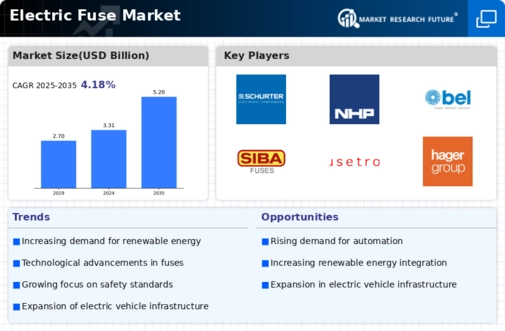
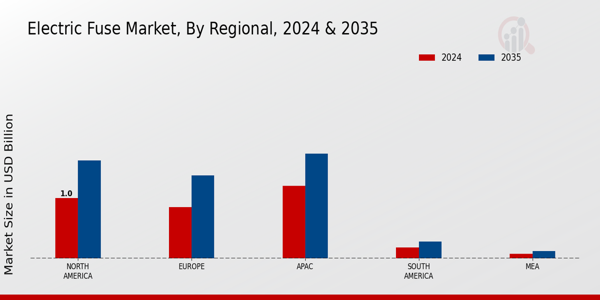

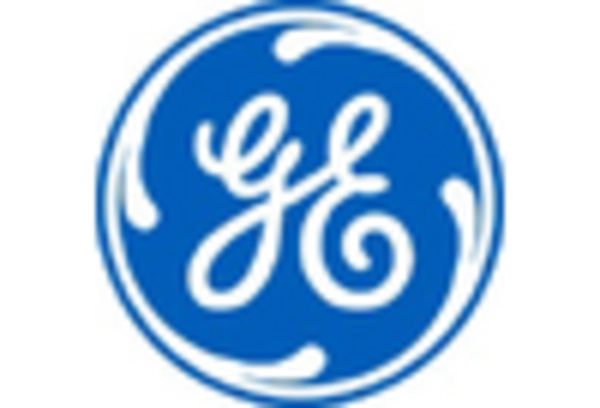
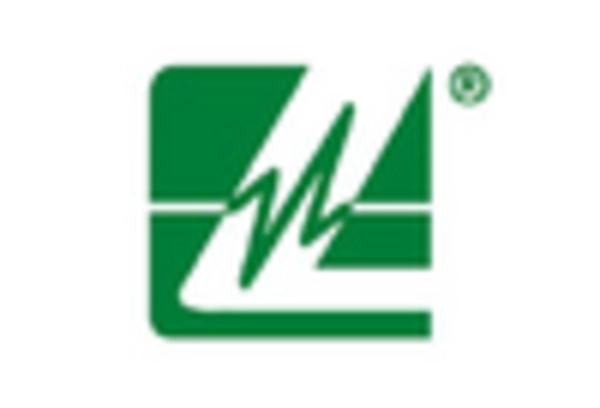


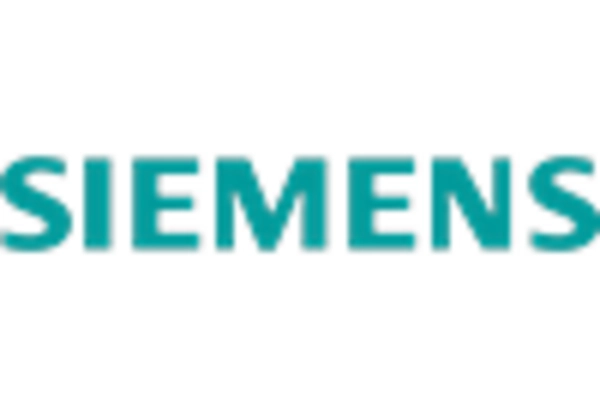

Leave a Comment